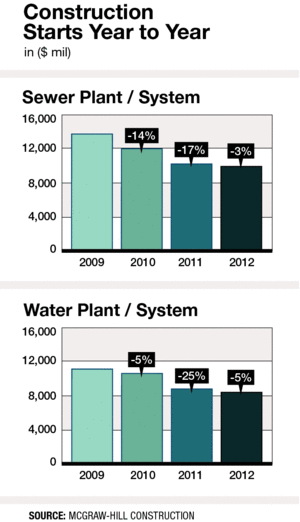

Regardless of size, location and system configuration, most of the water and wastewater utilities in the U.S. share a common attribute: the continuing need to upgrade and improve their treatment facilities and underground infrastructure.
Though the sluggish post-recession economy has largely removed capacity expansion from the list of priorities, there remains no shortage of needs on utilities' to-do lists.
Most often, the driver is meeting federal discharge mandates, as is the case with projects such as Cincinnati's $244- million combined sewer overflow (CSO) control project, which includes a 1.2-mile tunnel, a pump station and a high-rate treatment plant and, in Indianapolis, a nearly $3-billion program of deep storage tunnels, treatment plant expansions and collection system improvements.
Other utilities are being required to safeguard drinking-water sources from discharges, as is the case with the $4-billion nitrogen removal program under way at the Blue Plains Advanced Wastewater Treatment Plant in Washington, D.C., and the $227-million conversion of Tallahassee, Fla.'s Thomas P. Smith wastewater reclamation facility into an advanced wastewater treatment system.
There is also the need to improve water quality while also replacing aged systems. The New York City Dept. of Environmental Protection (NYCDEP) has $5-billion worth of upgrades at seven plants, including the Croton Water Filtration Plant, the $1.6-billion Catskill-Delaware ultraviolet-disinfection facility and the $800-million Manhattan portion of the City Tunnel No. 3 supply line.
But while the needs are plentiful, resources to fund them are not. As a result, utilities must continually re-evaluate their priorities, often setting aside basic repair and maintenance work so that the largest, most urgent—and often the most costly—elements can move forward.
Catherine Mallon, deputy commissioner for the NYCDEP's Bureau of Engineering Design and Construction, says that while her agency was fortunate to have the rate revenue in bonding to tackle these major construction projects, “they took up a big chunk of the program, which forced us to defer a lot of 'state of good repair' projects. We're only now able to start coming back to them.”
With NYCDEP's megaprojects scheduled to wind down in the next few years, the agency's 10-year agenda includes only two projects currently valued at more than $100 million each. “We'll still be spending about $1.5 billion over that period, only there will be a higher priority on maintenance and long-deferred projects,” Mallon adds.
Given the state of the economy, utilities are understandably hesitant to increase rates and broaden their construction buying power, even when there is widespread support for the improvements. Harlan Kelly, assistant general manager for infrastructure, San Francisco Public Utilities Commission (PUC), says his agency considered delaying some of the 81 projects that make up a $2.8-billion program designed to seismically harden the regional water treatment and distribution system as well as improve water quality. Elements of the seismic program include the $259.5-million Calaveras Dam, two tunnels totaling $440 million and the $174-million Harry Tracy Water Treatment Plant.
“There was concern that many customers would have difficulty managing the average $20 monthly increase in their water bills,” Kelly says, “but we realized that while you can put off construction work, you can't put off an earthquake.”


Post a comment to this article
Report Abusive Comment